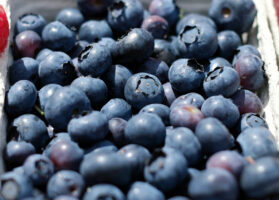Proarándanos: Blueberry industry confronted with significant spikes in sea freight costs
Overview of blueberries from Peru in the U.S. market, complemented by charts from Agronometrics. Original published on November 14, 2022.
Increased freight costs represent an additional US$ 3,000 to 5,000 per container, depending on the market. This significantly reduces the margin per hectare and, in some cases, leads the margin to a loss at certain times of the year. The increase in freight costs has an impact not only on the export of fruit, but also on the import of agroinputs required for operations.
Freight rates are up more than 70% compared to pre-pandemic levels.
The blueberry industry isn’t immune to the crisis either internationally or nationally, it is facing serious challenges, which require a collaborative attitude on the part of all actors in the value chain in order to be resolved, says the Peruvian Blueberry Growers Association (Proarándanos).
In addition, he said that a joint strategy is required to enable the operations viability of Peruvian exporters of all sizes to continue to focus on producing fruit with the highest standards of quality, fair employment and welfare for the country, through a successful and sustainable industry.
“In the last 10 years we have seen a continuous increase in blueberries exports – the so-called boom – which has placed Peru as a leader in this crop, and has generated significant development in several regions, previously without opportunities to get ahead. However, this growth will not be sustained in the future given the current situation,” he said.
The association explained that the blueberry industry is currently confronted with a significant rise in maritime freight costs, with increases of more than 70% compared to pre-pandemic levels. This increase represents between US$ 3,000 and 5,000 additional dollars per container, depending on the market. “This significantly reduces the margin per hectare and, in some cases, leads the margin to a loss at certain times of the year”.
Proarándanos said that the rise in freight rates has an impact not only on the export of fruit, but also on the import of agroinputs required for operations. “These costs cannot be passed on to international buyers, as the market does not allow us to increase the prices of the fruit we export”.
He added that other problems are: Higher shipping rates compared to other commodities under the same conditions and to the same markets; the shortage of containers and the closure of destination ports; the poor flexibility of shipping companies with respect to associated costs, such as charges for cancellations; the collapsed national infrastructure that is generating a significant impact on operations.
The association pointed out that in this 2022-2023 season, the main markets for Peruvian blueberries, such as Europe and the United States, are going through difficult times, as a result of the recession and the war, which have had a strong impact on the consumption of fruit such as blueberries. Added to this is the poor participation of the state in its promotional role and excessive regulation that affects the competitiveness of the sector.

Source: USDA Market News via Agronometrics.
(Agronometrics users can view this chart with live updates here)
“On behalf of the blueberry producing and exporting companies in the country, we do a call attention to the challenges confronted by the blueberry industry at this time, with the objective that the entire value chain involved in the agroexport of this fruit can know the reality of the situation and that we can reach a solution that does not endanger the sustainability of many companies that generate work for more than 250,000 families, directly and indirectly, in more than 10 regions of Peru,” said the Association.
Finally, he said that logistics companies, shipping companies and all others involved in the export of this fruit need to be true strategic partners so that, together, they can overcome the problems that this industry is currently facing.
The News in Charts is a collection of stories from the industry complemented by charts from Agronometrics to help better tell their story.
Access the original article with this (Link)






